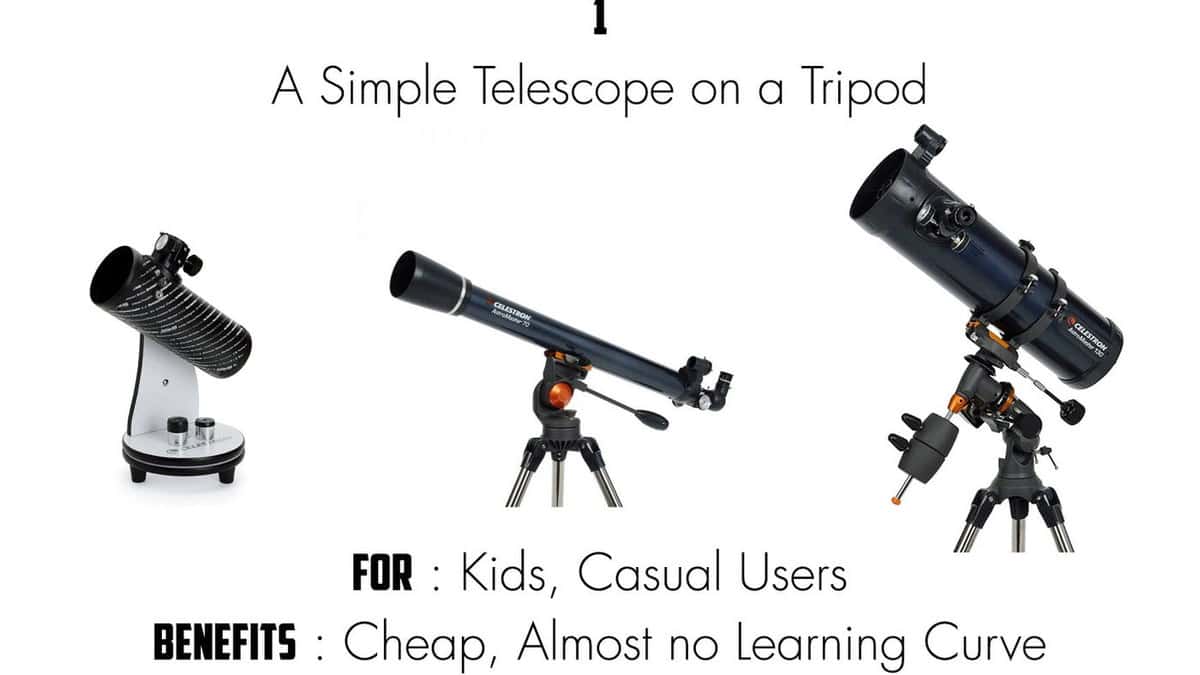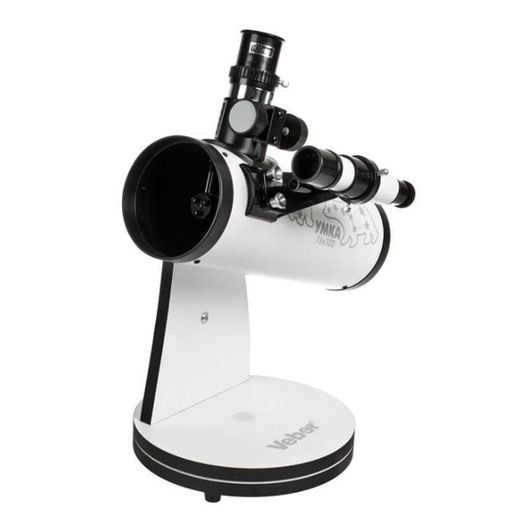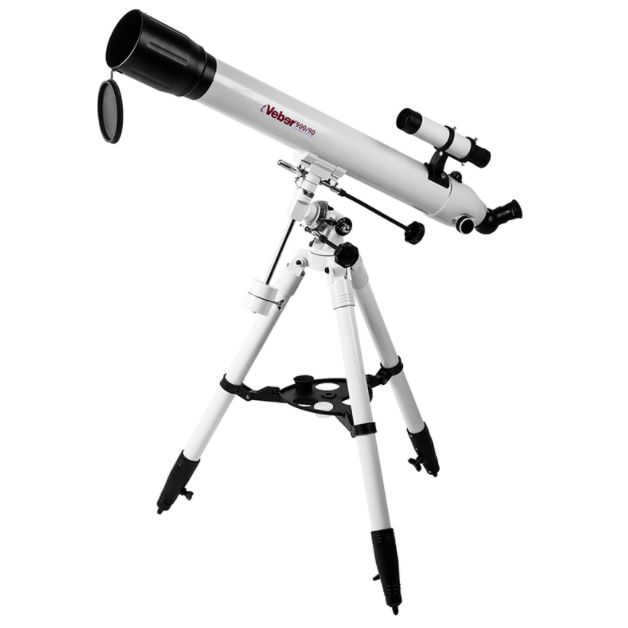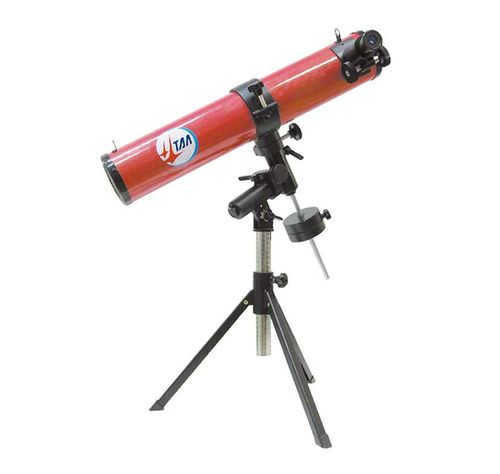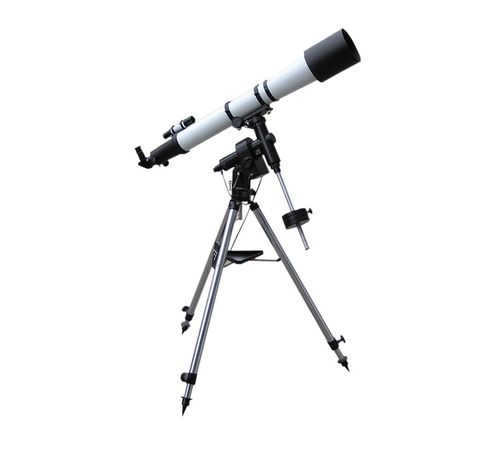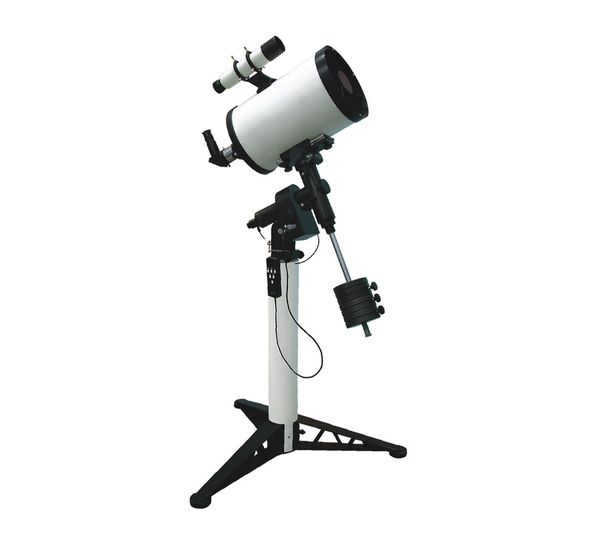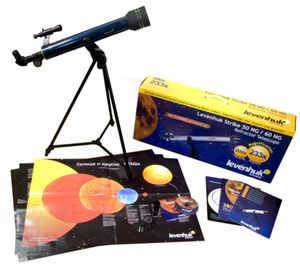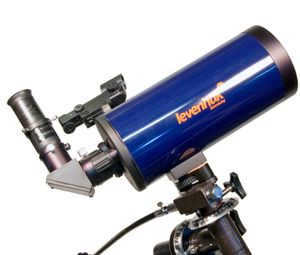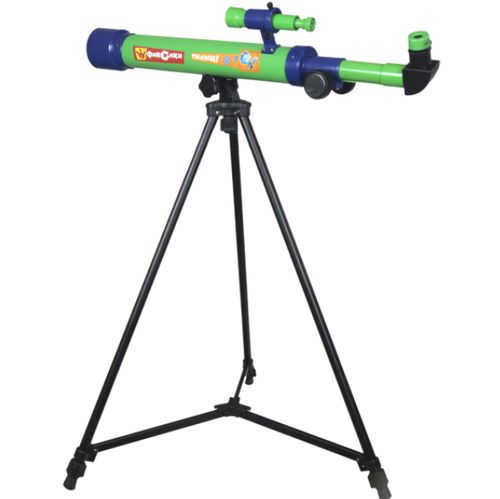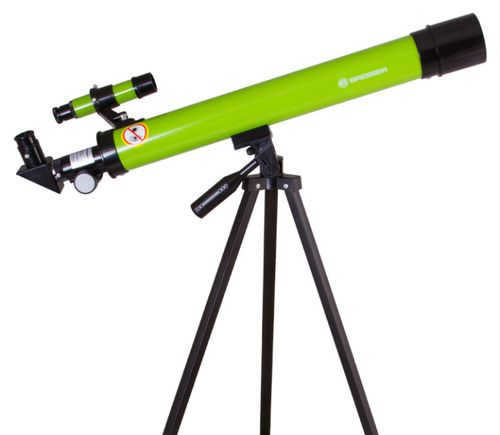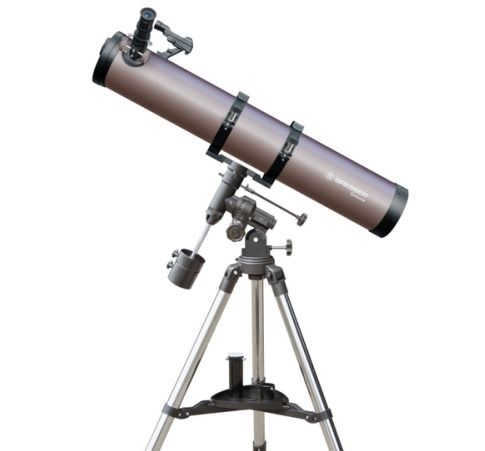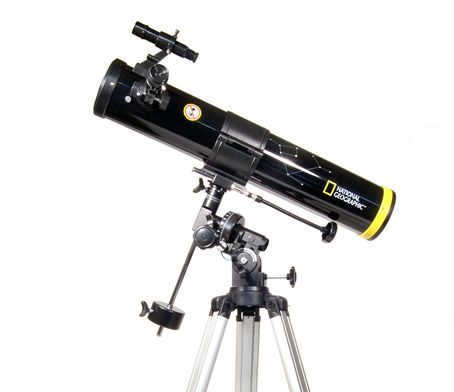The night sky is captivating and has mesmerized humanity for thousands of years. We have marveled at the twinkling lights and attributed divine origins to constellations, believing they hold power over our destinies. Even today, the stars continue to enchant us, although we now possess the knowledge to determine their distance and calculate the paths of celestial bodies. However, for a significant period of time, the ability to observe the wonders of space was limited to scientists. Creating telescopes was a complex and expensive task, accessible only to large scientific institutions.
With the advent of technology, the situation has undergone a dramatic transformation: now, not only schools but almost every family can afford high-quality optical devices. Commercial manufacturers of telescopes are competing with each other in terms of the quality of their optics, precision mechanics, and level of automation. However, there are only a few companies whose telescopes can be unequivocally recommended for purchase. The main factors to consider when choosing a manufacturer include:
- Optical quality.
- Mechanical accuracy.
- Device reliability.
- Telescope cost.
- Range variety.
- Ergonomics.
- Availability of additional accessories.
Our review focuses on the top telescope manufacturers for both amateur and professional astronomers. To determine our ratings, we considered the opinions of respected astronomical magazines and analyzed reviews from popular stargazing forums. Several key factors were taken into account:
- The company’s reputation;
- Recommendations from professional astronomers;
- The balance between price and quality.
Top 10 telescope companies
10 Veber

This particular brand offers a wide range of telescopes with various optical systems, including both azimuthal and equatorial mounts. What sets this company apart is the abundance of features and accessories that even their budget models come with. Each telescope is equipped with multiple eyepieces, a finder, and a Barrow lens. Additionally, some models also include a convenient carrying bag and a set of filters.
The company stands out for its wide range of models of table tripods, reliable mounts that absorb vibrations, and a sleek monochrome design. Although the company’s lineup does not include professional telescopes, it offers a variety of high-quality devices at affordable prices, suitable for both beginner and advanced amateur astronomers. One particularly popular choice among young astronomers is the “Umka” reflector telescope on a table tripod. With its exceptional optics, users can observe the moon, planets of the solar system, and even some deep space objects. Additionally, this telescope is designed in an elegant white color and features images of the characters from the cartoon with the same name.
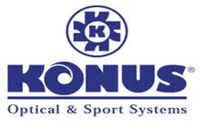
The telescopes produced by this company have a specific focus on amateur astronomers, but they stand out for their consistent quality and excellent ergonomics. The range includes advanced tripods, including both floor-standing and tabletop options, which are lightweight and feature an appealing design. These are the standout features of Konus telescopes. There is a wide selection of telescopes available for young astronomers, and older models often come equipped with an electric drive for automatic tracking.
Simply put, these telescopes are convenient and considerate tools for observing the celestial sky both at home and on the go, making them ideal for beginners, children, and teenagers. Astrography enthusiasts will also find it effortless to select the perfect telescope from the company’s range of models.
8 Sturman
can be paraphrased as
Eight Sturman
.


This company offers a range of telescopes to suit every budget, from affordable options to more expensive models. Even the lower-priced telescopes still offer acceptable quality in terms of optics and mechanics. The company primarily targets amateur astronomers, but they also have excellent options for children that are simple and inexpensive. These beginner telescopes are a great way to gauge a child’s interest in astronomy before deciding to invest in more advanced models.
Seven TAL

Novosibirsk Refinery manufactures telescopes of this brand. Discerning enthusiasts consider the optics to be of excellent quality. This is evidenced by the fact that over half of the produced optical systems are exported. TAL telescopes are also highly favored by astrography enthusiasts, as the image quality they provide is truly astounding. However, the mechanics of these telescopes have some traditional flaws commonly found in domestic instruments: they are quite heavy and, according to users, designed without much consideration for user comfort.
It is important to mention that despite these drawbacks, there are numerous domestic amateur astronomers who are loyal fans of TAL telescopes. After all, for a genuine admirer of the celestial sky, superior optics is the main priority. Frequently, experienced astronomers acquire solely the optical tube, along with a compatible mount and tripod.
6 Orion
Rephrase the text, making it unique, using the English language and preserving the HTML markup:
6 Orion
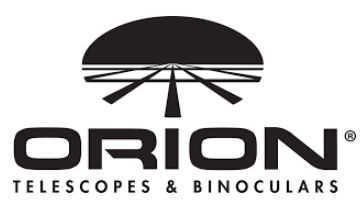
This particular brand, which has been operating in the American market since 1975, has a highly specialized focus – exclusively dealing with telescopes and nothing else. As a result, according to the highly regarded astronomy magazine Sky & Telescope, even the entry-level Orion models offer the optimal combination of superb optics and precise mechanics compared to other top telescope manufacturers. Additionally, the company’s engineers place great emphasis on innovative technology, making Orion a recognized leader in telescope software development for automated pointing.
The autolocation process is greatly simplified by the Intelliscope system, reducing the need for precise pointing. With a database of 14,000 celestial objects, the program can automatically identify and track them. It’s worth noting that Orion software is also used by other leading telescope manufacturers. Additionally, Orion offers a collection of luxury optical instruments housed in a brass case, designed with a retro aesthetic. Customers consider these instruments to be an excellent gift option, providing the opportunity to appreciate the beauty of the night sky while also adding a touch of classic style to any interior. The only drawback is the higher price, which reflects the premium quality of these telescopes.
5 Levenhuk
can be paraphrased as:
Levenhuk 5
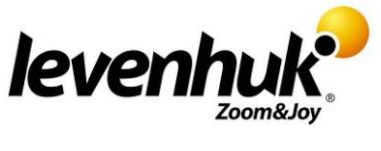
Thanks to their competent approach to telescope selection, exceptional design, and excellent customer service, this Russian startup has quickly risen to become one of the top ten sales leaders in Russia. While the company offers a wide range of optical devices for advanced amateur astronomers, their Levenhuk telescopes for children and teenagers have gained the most popularity.
4 Bresser
Rephrase the text, making it unique, using the English language and preserving the HTML markup.

The company has a rich history of producing optical instruments for over 50 years. It initially started with the sale of binoculars and eventually expanded its product line. The telescopes manufactured by this company stand out for their exceptional optical quality. Additionally, the company’s products are known for their meticulous German engineering in terms of pointing and adjustment mechanisms. They offer user-friendly azimuthal mounts for beginners, while professional instruments feature equatorial systems, and computerized pointing is also widely available.
Bresser was selected by the renowned scientific and educational organization National Geographic to collaborate on developing a range of telescopes aimed at promoting a wider interest in astronomy. The Bresser National Geographic models have since become the benchmark for amateur telescopes, recognized as among the finest available on the market.
Three Meade
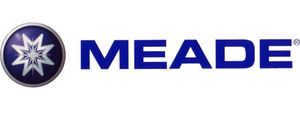
Meade, an American telescope manufacturer, consistently holds the top spot in producing telescopes. The company’s team of engineers designs both simple and compact telescopes at a relatively affordable price for beginners, as well as large and technologically advanced telescopes for professionals. The prices of these telescopes can reach incredibly high values. Meade incorporates numerous unique techniques in their optical systems, such as high-precision optical coatings to enhance lens transmittance, meticulous hand polishing and finishing to prevent distortion, thorough intermediate testing, and rigorous final quality control.
When it comes to user-friendliness, Meade’s guiding principle is straightforward: stargazing should be accessible to everyone, regardless of their level of expertise. That’s why a majority of the company’s amateur telescopes come with automatic pointing systems and are designed to be user-friendly and enjoyable to use.
2 Celestron
can be rephrased as
Celestron 2
or
Second Celestron
.

At one point in time, Celestron was the pioneering company that manufactured large aperture telescopes for commercial use. This was made possible by the innovative efforts of the company’s engineers in developing the technology for mass-producing mirror-lens optical tubes. The iconic orange color and memorable design make Celestron optical devices easily recognizable even from a distance. Additionally, the company offers a convenient classification system for its telescopes, such as the FirstScope series, which is specifically designed for beginners and was officially recognized as the telescope of the International Year of Astronomy in 2009.
For travelers and tourists, there is a specific range of products available: Travel Scope devices are both lightweight and compact. A large number of these models are fully computerized and can be controlled through a smartphone. Celestron telescopes are particularly popular in astronomy facilities within educational establishments such as schools, colleges, and universities.
1 The Observer of the Skies

This company provides the widest selection of telescopes for stargazing enthusiasts, catering to both beginners and advanced amateurs. SkyWatcher offers 15 different series of devices designed for observing celestial objects, including telescopes with various popular optical systems and mounts. While the brand primarily focuses on producing products for amateur astronomers, the older models might also be of interest to professionals.
The reason for the popularity of this brand among buyers is easily explainable: David Shen, the founder of SkyWatcher, dedicated a lot of effort to ensuring that the telescope was of high quality, easy to use, and affordable for everyone. SkyWatcher telescopes have gained an excellent reputation worldwide. According to Russian buyers, these telescopes offer the best price-quality ratio on the market.
Important! The information provided above is not a buying guide. For any advice, it is recommended to consult a specialist!
Galileo was the first to utilize the already existing telescope for observing celestial bodies. The magnification provided by his optical device was only three times, but it was sufficient to spark rapid technological progress: within six months, the scientist achieved an eightfold magnification, and shortly after, a 32-fold magnification.
When purchasing a good telescope, it is crucial to take into account the frequency of its use. The observer’s skill level plays a significant role, and expertise is gained through experience, as they say. It is advisable to define the purpose of the device, its design (whether it is stationary or portable), the type of mount it has, and the type of pointing it offers before making a purchase.
Tips for selecting the perfect telescope
The top affordable telescopes for beginners: with a budget of up to 20,000 rubles.
Telescopes in this category offer versatile features that make them suitable for observing both the planets of the solar system and objects in deep space (deep-sky). The selected telescopes have a lens diameter of no more than 90 mm, which may limit the visibility of faint objects, but also reduces light pollution, allowing for city use. It’s important to note that beginners may not want to invest a large amount of money in their first amateur device, so we will stick to a budget of twenty thousand rubles.
3 Weber 400/80 AZ
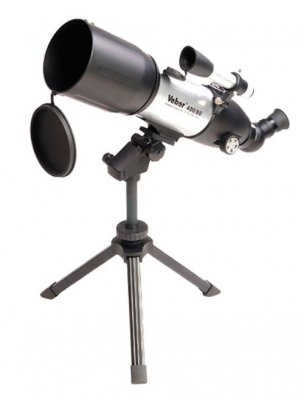
Affordable and well-balanced features
Country: Russia (produced in China)
Average price: 6550 rubles.
Rating (2023): 4.8
The Veber 400/80 AZ is a typical example of a beginner-level telescope. It is a refractor-achromat with an 80 mm objective lens. Although it has a small aperture, it still provides clear views even in urban areas with minimal light pollution. It is also worth mentioning its impressive focal ratio, which delivers vibrant and bright images.
A Brief History of the Invention and Advancement of Telescopes
The first person to discover how to utilize an already existing telescope for observing celestial objects was Galileo. Initially, his optical device provided a magnification of only three times, but this was sufficient to spark rapid technological advancement. Within six months, the scientist managed to achieve an eight-fold magnification, and shortly after, a thirty-two-fold magnification.
As optics and technology progressed, it became evident that the size of the lens played a crucial role in both magnification and image quality. Nowadays, the telescopes employed by professional space explorers are colossal in size. For instance, in the Atacama Desert in Chile, there is an ongoing construction of a structure with a diameter of 39.3 meters, known as the European Extremely Large Telescope.
However, regular individuals who enjoy observing the stars are not limited to a mere 32x magnification like Galileo had. Even smaller telescopes designed for children can provide a useful magnification of up to 100x! And standard telescopes for more experienced enthusiasts can magnify up to 200x, offering a high-quality image with minimal distortion.
2 LEVENHUK Strike 90 PLUS: The Ultimate Choice for Astronomers.
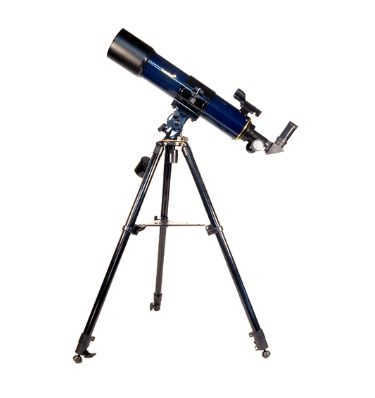

If you’re a beginner looking to observe the Moon and planets in our Solar System, this telescope is the perfect choice. It is manufactured in China but comes from Russia, and has an average price of 19400 rubles. With a rating of 4.9 in 2023, it’s clear that this telescope is highly regarded by users.
This particular amateur telescope is known for its convenience and ease of use. It features an azimuthal mount, which means it doesn’t require any presetting before you start observing. For beginners, there’s a red dot viewfinder attached to the telescope tube, making it simple to locate objects even in dark skies. The kit includes three eyepieces, a compass, and a 3x Barlow lens. The maximum magnification achievable with the included eyepiece is 300x. The objective lens has a standard diameter of 90 mm, which is typical for telescopes in this category.
1 Celestron AstroMaster 90 AZ
Celestron AstroMaster 90 AZ is a top-of-the-line telescope designed for astronomy enthusiasts. With its 90mm aperture and AZ mount, this telescope offers stunning views of the night sky.
The AstroMaster 90 AZ features a fully-coated lens system that provides sharp and clear images of celestial objects. Its 90mm aperture allows for impressive light-gathering capabilities, making it ideal for observing planets, stars, and even deep-sky objects.
Equipped with an AZ mount, this telescope is easy to set up and use. The mount provides smooth and precise movements, allowing for effortless tracking of celestial objects. It also comes with a sturdy tripod that ensures stability and durability.
Whether you are a beginner or an experienced astronomer, the Celestron AstroMaster 90 AZ is a great choice for exploring the wonders of the universe. Its high-quality optics, user-friendly design, and affordable price make it a popular option among stargazers.
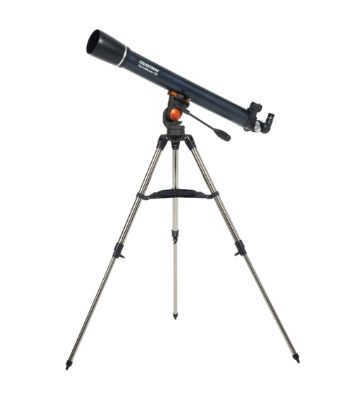
The most versatile model
Country of origin: United States (manufactured in China)
Average price: 16990 rubles.
Rating (2023): 5.0
This is a versatile and affordable model that is suitable for both observing the stars and terrestrial objects. It is designed for amateur astronomers and is user-friendly. It is particularly recommended for beginners because of its special optical system, which ensures that the telescope image is correctly oriented. Other advantages include the specialized software “TheSkyX – First Light Edition” for identifying celestial bodies from a database of 10,000 objects, as well as a sturdy German equatorial mount.
The diameter of the objective lens is 90mm, and the maximum magnification with the included eyepiece is 100x. The wide range of magnification, from 13x to 213x, allows for observation of objects at various distances. Customers who selected this particular model have consistently been pleased with their decision. In their positive reviews, they often highlight the product’s exceptional quality and excellent craftsmanship. Many also appreciate the ease of assembly, even for beginners, as well as the outstanding optics. Overall, this telescope is widely regarded as an exceptional choice for home use.
The top telescopes for exploring the vast cosmos
Over time, amateur stargazers find themselves yearning for more than just the confines of our solar system. While the visible planets have all been thoroughly studied, there is always a desire to discover something new. In this scenario, investing in a specialized telescope built for observing distant galaxies, nebulae, star clusters, and other celestial objects can be the perfect solution. These types of telescopes typically have a reflector with a diameter exceeding 200 mm. A larger aperture allows for the collection of more light, making it ideal to venture outside of urban areas to avoid the interference caused by artificial light. It’s important to note that the increased size of the lens also leads to a larger overall size of the device, resulting in added weight, reduced portability, and higher cost.
3 Meade LightBridge 12″ f/5 Truss-Tube Dobsonian
can be rephrased as
Three Meade LightBridge 12-inch f/5 Truss-Tube Dobsonian Telescopes
while preserving the HTML markup.
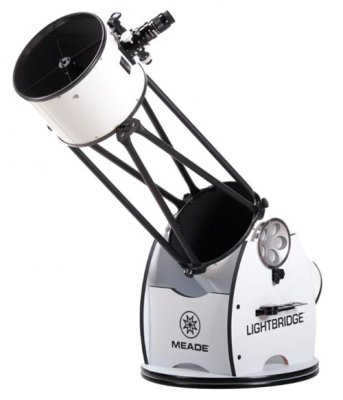
Before us is a reflector telescope equipped with a 305 mm lens, which offers an incredibly impressive aperture and, as a result, exceptional image clarity. The magnification capabilities of this telescope are also outstanding, reaching up to 600x. It is worth mentioning that the telescope can be disassembled for easy transportation. The only drawbacks are its high price and the fact that it requires two-inch eyepieces, which can make it challenging to find replacements.
Among the advantages, users appreciate the telescope’s ability to provide a very high level of magnification, its excellent f/5 aperture, and its impressive resolving power of 0.45 angles per second. The inclusion of a red dot finder makes it easier for beginners to locate celestial objects in the dark sky, which is a significant benefit. Users also appreciate the extensive equipment that comes with the telescope. However, some disadvantages include the complexity of the design, which may only be suitable for experienced users, as well as its heavy weight and high cost.
2 Sky-Watcher Dobsonian 8″ (200/1200)
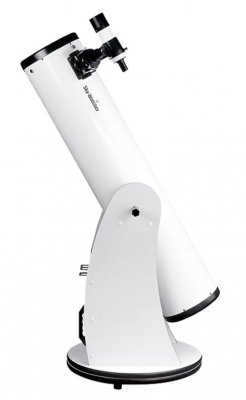
The preferred choice for buyers
Location: Canada (manufactured in China)
Average cost: 37390 rubles.
Rating (2023): 4.8
Telescopes from Sky-Watcher are highly favored by enthusiasts of distant space. It’s no surprise, as their instruments are renowned for their excellent craftsmanship and well-balanced features. However, it would be a stretch to label them as the absolute best. While they boast a 203 mm lens and a considerable focal length, which theoretically provides superior magnification, the actual improvements over the leading competitor are only marginal, yet the price is significantly higher. Therefore, the main advantage is their widespread popularity, which makes it easy to purchase one and connect with other owners.
1 Weber 800/203 EQ
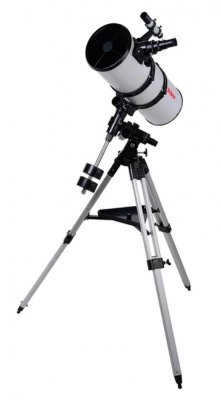
★ The best combination of price and functionality
Country: Russia (manufactured in China)
Average price: 21209 rubles.
Rating (2023): 4.9
This device shares some similarities with the second-place telescope in our ranking. It also features a 203 mm lens, although the shorter focal length leads to slightly lower resolving and penetrating abilities. However, the maximum useful magnification remains the same at 403x. So why is this telescope with slightly inferior characteristics considered the best? The answer is simple – it is nearly 10 thousand rubles cheaper. Additionally, it comes with a full-fledged tripod, allowing for clear field observation. Furthermore, the equatorial mount makes observation easier.
Additionally, customers highlight several benefits of the telescope in their reviews. These include its lightweight design (weighing just 26 kg), the ability to be set up on a tripod, and a maximum magnification of 246x when used with the included eyepiece. Furthermore, there have been no complaints regarding the quality of its construction. However, more experienced stargazers argue that it would be impossible to find a good 200 mm Newton telescope with a mount at a similar price point. Therefore, this model is only recommended for those who are new to astronomy and have less experience.
The top telescopes featuring automatic guidance
The concept behind these instruments is straightforward: they consist of a regular telescope equipped with a specialized mount that automatically directs itself towards the desired celestial object using motors. This feature makes them ideal for both beginners and experienced astronomers looking to optimize their time. However, it’s important to note that telescopes with automatic pointing necessitate initial setup, batteries, and are generally more expensive than their manually-controlled counterparts.

The Bresser refractor telescope may not have the largest lens diameter (only 70 mm), but it boasts numerous other advantages. Its main selling point is its unparalleled German quality. Every aspect of this telescope is flawless – from the materials used to its assembly, accuracy, and image clarity. With a useful magnification range of 18x-88x, it is particularly well-suited for observing the Moon and other nearby celestial objects.
Using the device is a truly enjoyable experience – it can be easily installed on the floor using a tripod, it has automatic pointing and an azimuthal mount, as well as a tracking mechanism. Users also appreciate the additional advantages of the GoTo remote control, lunar filter, and movable map of the starry sky. However, the standout feature of this telescope is its extensive database, which contains approximately 272,000 objects – significantly more than other models with automatic guidance. The only drawback is that this telescope is better suited for beginners rather than advanced users, primarily due to its smaller lens diameter.
2 Sky-Watcher Dobsonian 8″ (200/1200) Telescope with Retractable Tube and SynScan GOTO
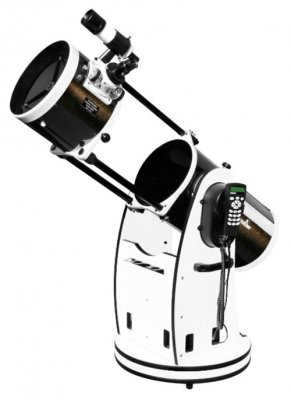
Convenient transportation
Country: Canada (produced in China)
Average cost: 97000 rubles.
Rating (2023): 4.9
The reflector telescope with a Newton optical system, a lens diameter of 203mm, and a focal length of 1200mm is a fantastic option for those interested in observing distant celestial objects. The effective magnification ranges from 34x to 406x, which is quite impressive, and the automatic pointing and tracking mechanism ensures that observation is both easy and enjoyable, even for less experienced users.
1 Celestron NexStar 8 SE.
Celestron NexStar 8 SE is the first choice for many astronomy enthusiasts.
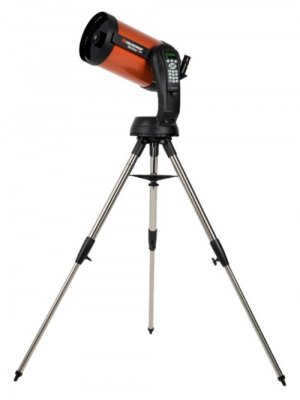
The best accuracy when pointing
Country: USA (produced in China)
Average price: 130,945 rubles.
Rating (2023): 5.0
This telescope employs the Schmidt-Cassegrain optical design, which makes the “tube” very compact while maintaining image quality. The maximum useful magnification (480x) and resolving power (0.57 arc sec) are considered excellent indicators. It is also worth noting the option of floor installation, which allows for observation even in open fields.
Lastly, one should appreciate the advanced control system of the NexStar 8 SE – you can use the built-in 19-key remote control with a two-line LCD screen, as well as the proprietary NexRemote system for PC, which provides incredible opportunities. The only downside is its high cost.
The top telescopes for kids and adolescents
Parents are especially selective when it comes to choosing optical devices for their young astronomers. It’s not just about nurturing their child’s budding interest in stars and planets, but also about fueling their thirst for knowledge and ensuring that they aren’t overwhelmed by complex adjustments and controls. That’s why the most popular telescope series for children are known for their attractive designs, easy-to-use pointing systems, and additional features like star charts and digital planetariums.
3 Meade Infinity 50mm
can be rephrased as
Three Meade Infinity 50mm Telescopes
.
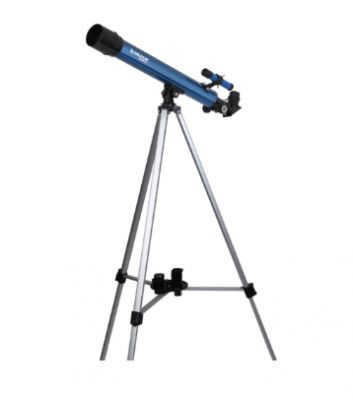
★ Get maximum functionality for minimum money
Country: China
Average price: 3990 rubles.
Rating (2023): 4.7
This telescope is the perfect gift for a child. Despite its affordable price, it is equipped with automatic pointing and offers a useful magnification range of 30x-150x. The long focal length lens, made from a pair of achromatic lenses, produces images with minimal distortion, and the telescope’s design allows for compatibility with a variety of astronomical accessories, such as Barlow lenses, filters, and eyepieces.
According to a large number of stargazing enthusiasts, this particular affordable telescope for children is considered to be the top choice. It is highly praised for its exceptional image quality and excellent manufacturing. There are no significant drawbacks, except for the slightly inconvenient mounting system that lacks adjustment for the friction force on the azimuthal axis. Overall, this telescope is considered to be perfect in every other aspect.
Veber UMKA 76/300 Telescope: A Versatile Choice
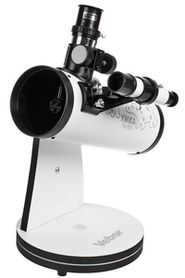
An ideal telescope for observing the planets of our solar system is a compact and stylish reflector mounted on a Dobsonian mount. To get a detailed view of the moon, this telescope kit comes with multiple interchangeable lenses and a lunar filter. The turret mount, which is stable and doesn’t take up much space on a table, is particularly suitable for children who are learning how to use a telescope. The telescope’s smart white color and the image of Umka, the bear from the popular cartoon, make it a perfect addition to any nursery’s interior.
Customers are pleased primarily with the fantastic price, as well as the unique design and user-friendly interface. The telescope also comes with a wide range of lenses and filters, which is another advantage. However, if you consider long-term use, this telescope may have some drawbacks – it is very basic and can only be used to observe the moon and the planets within our solar system. Therefore, in the future, you might need to invest in a more advanced device with enhanced features.
1 BRESSER Junior Space Explorer 45/600 AZ
can be rephrased as:
1 BRESSER Junior Space Explorer 45/600 AZ
is a product that allows children to explore space.
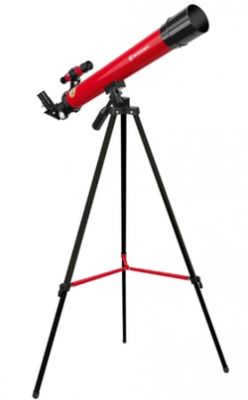
The BRESSER Junior telescopes have been specifically designed for children and teenagers. These traditional refractors with azimuth mounts come with a lightweight aluminum tripod that can be adjusted to accommodate children of any height. The housing is available in various colors, including red, blue, green, and even pink. The set includes multiple eyepieces, including a wraparound one, making it suitable for ground-based observations as well.
Based on customer feedback, this product is an excellent choice for a children’s gift for those interested in astronomy. It features an appealing design, Bresser’s renowned high-quality optics, and easy operation – everything necessary for observing the night sky and fostering a passion for science. Its advantages also include a reliable construction, affordable price, and good equipment. The only downside mentioned is the small lens diameter, which measures just 45 mm.
The top portable telescopes for travelers
The optical tube of a telescope, especially with a larger lens, is a complex system consisting of lenses and mirrors, making it difficult to downsize. The mount and tripod also contribute to the overall size and weight of the device. However, when it comes to observing celestial bodies in areas without light pollution or air pollution, such as open fields, mountains, or the sea, a portable telescope becomes especially useful. For travelers who enjoy stargazing, there are specially designed lightweight telescope models that incorporate various innovations, allowing for convenient and safe transportation to observation locations.
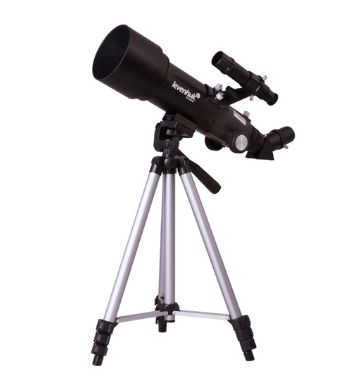
★ The LEVENHUK Skyline Travel 70 telescope is a compact model with automatic pointing.
Country: Russia (manufactured in China)
Average price: 7990 rubles.
Rating (2023): 4.7
Designed specifically for traveling rather than home use, the LEVENHUK Skyline Travel 70 telescope features a shortened optical tube and minimal weight. It can be easily folded and fits into a small backpack, which is included in the package. The telescope is equipped with an easy-to-use azimuthal mount, making it suitable for beginners. Additionally, the lightweight aluminum tripod with height-adjustable legs allows for sky observation from any location.
The telescope is equipped with a complete set of essential accessories, including a Barlow lens, two eyepieces, and a diagonal mirror. It offers a useful magnification range of 12x-140x. What sets this model apart is its automatic pointing capability, which is not commonly found in more affordable options. Despite thorough examination, no significant drawbacks have been discovered, making it safe to say that this telescope can be considered one of the finest choices available.
2 Sky-Watcher BK Mak90EQ1
The Sky-Watcher BK Mak90EQ1 is a highly versatile telescope that offers exceptional performance and convenience. With its Maksutov-Cassegrain design, this telescope is perfect for both celestial and terrestrial viewing.
Featuring a 90mm aperture and a focal length of 1250mm, the BK Mak90EQ1 provides clear and detailed views of the night sky. Whether you’re interested in observing the moon, planets, or deep-sky objects, this telescope has you covered.
The included EQ1 equatorial mount allows for easy tracking of celestial objects. It also features slow-motion controls, making it simple to navigate the night sky and keep your target in sight. The mount is sturdy and stable, ensuring steady views even at high magnifications.
The BK Mak90EQ1 comes with a 10mm and a 25mm eyepiece, providing a range of magnification options for different observing conditions. It also includes a red dot finder scope, which makes locating objects quick and easy.
This telescope is compact and lightweight, making it highly portable. It’s perfect for taking on camping trips or other outdoor adventures. The BK Mak90EQ1 also comes with a sturdy tripod, which adds to its overall stability and ease of use.
If you’re looking for a versatile and reliable telescope, the Sky-Watcher BK Mak90EQ1 is an excellent choice. Its high-quality optics and convenient features make it a great option for both beginners and experienced astronomers alike.
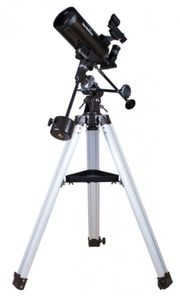
Plenty of features available at an affordable price
Country: Canada
Average cost: 24270 rubles.
Rating (2023): 4.8
This telescope with a 90mm aperture is a member of the mirror-lens telescope family that is constructed based on the Maksutov-Cassegrain design. The optical tube is only 240mm long due to this fact. Its compactness and reliability are the defining characteristics of this telescope, making it suitable for use at home or in the countryside. It handles backlighting well, but the best image quality is achieved in natural settings where light pollution is minimal.
Users of the telescope highly appreciate its superb optics and advanced equatorial mount. According to seasoned users, the device delivers images with outstanding clarity and contrast, making it top-notch. Although the price of the telescope is quite high, it can be confidently called a versatile model. From all of this, users conclude that its main advantage lies in the extensive capabilities it offers within this price range. The only drawback, it seems, is its high price.
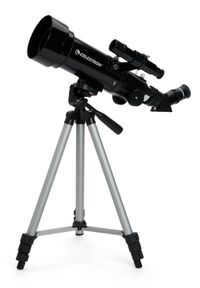
This refractor on the azimuthal mount is specifically designed for frequent travelers, but it is also suitable for home use. It weighs only 2.888 kg and can easily fit into the convenient backpack that is included in the package when it is disassembled. The sturdy tripod allows you to set up the device for use at home or outdoors in just a few minutes. Additionally, the included lens wrap-around enables you to utilize the telescope for ground-based observations.
Despite being a budget-friendly device, Celestron does not compromise on the optics of this telescope – its high-quality optical system allows for a maximum useful magnification of 165x. Some users have mentioned the tripod’s poor stability as a disadvantage, but this is mainly due to its lightweight design.
Important! The information provided above is not intended as a purchasing guide. For any advice, please consult with a professional!
Observing the magnificence of distant celestial objects has become an enthralling pastime not only for discerning stargazers, but also for amateur astronomers and curious schoolchildren. Exploring the depths of space is made effortless with the aid of powerful optical instruments found in observatories. However, it is far more convenient to do so from the comfort of home with a high-quality telescope, allowing for hours of awe-inspiring views of lunar landscapes and the graceful flight of comets.

Choosing the Best Telescope Manufacturer – Which Company to Go For
When it comes to the Russian market for optical equipment, telescopes may not be the most popular item, but there is still a decent range available from many well-known companies.
Leading manufacturers cater to users of all levels, offering comprehensive series for beginners as well as affordable options specifically designed for children and teenagers.
Famous brands take great pride in their telescopes for professionals, which have evolved into more than just optical devices and are now considered high-tech and “smart” instruments.
In 2017, the top-selling amateur and semi-professional telescopes were produced by the following manufacturers:
Discover more about the top-rated models from these brands in our telescope rankings. However, when selecting a telescope, it is crucial to prioritize your optical requirements. Our guidance will assist you in determining the type of device that suits your needs.
Telescope Operation Principle and Device

A telescope is a sophisticated optical device that allows for the observation of distant objects (either astronomical or terrestrial) at various levels of magnification.
Structurally, a telescope consists of a tube, with a light-gathering lens and/or a concave mirror (the objective lens) at one end, and an eyepiece at the other end, through which the resulting image is viewed.
Additionally, telescope designs may include:
1. A finder scope to locate specific astronomical objects;
2. Light filters to reduce the brightness of stars;
3. Diagonal mirrors (correcting plates) that invert the image produced by the objective lens.
1. Advanced electronic devices;
Categories of telescopes
Refractors (lenticular)
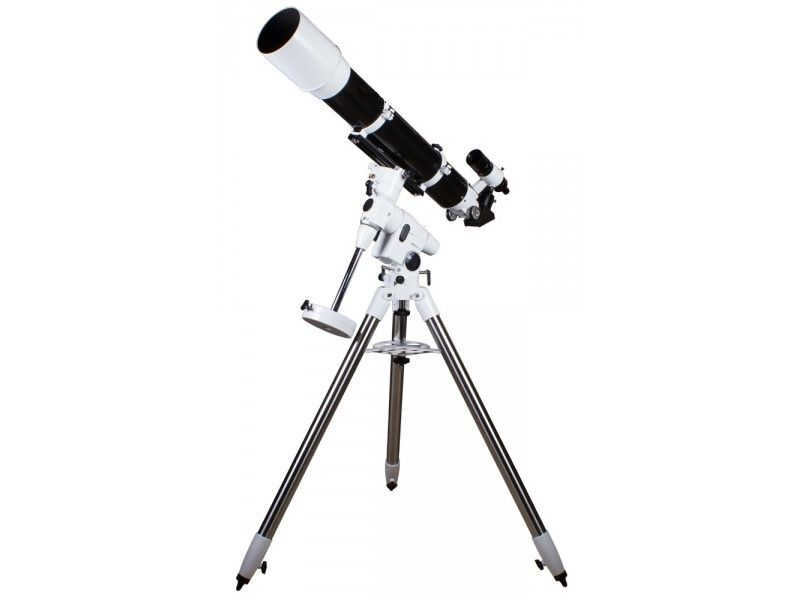
Identify this type of telescope by its simple design, resembling a traditional telescope. The lens and eyepiece are aligned along the same axis, and the enlarged image is transmitted directly – just like the original instruments created 400 years ago.
Refractors, also known as refracting telescopes, gather the reflected light of celestial objects using 2-5 double-convex lenses placed at opposite ends of a long tube. This particular type of device is well-suited for beginners and amateur astronomers, as it provides a clear view of both terrestrial and celestial objects within our own solar system.
The lenses used in refractor telescopes scatter the light that enters the lens into different colors, which can cause a decrease in image clarity and make it appear dimmer when using high magnification. It is recommended to use this type of telescope in a location outside of the city, where there is minimal light pollution.
- These telescopes are easy to use and do not require specialized maintenance;
- They have a sealed design that protects them from dust and moisture;
- They are not affected by temperature changes;
- They provide clear and detailed views of nearby celestial objects;
- They have a long lifespan.
- Refractor telescopes can be quite bulky and heavy (some models weigh up to 25 kg);
- The maximum lens diameter is 150 mm;
- They are not ideal for observations in urban areas.
The classification of telescopes is based on the type of lens they have:
1. Achromatic telescopes have small and medium magnifications, but provide a flat image.
2. Apochromatic telescopes create a more convex image and eliminate issues like blurred edges and secondary spectrum effects.
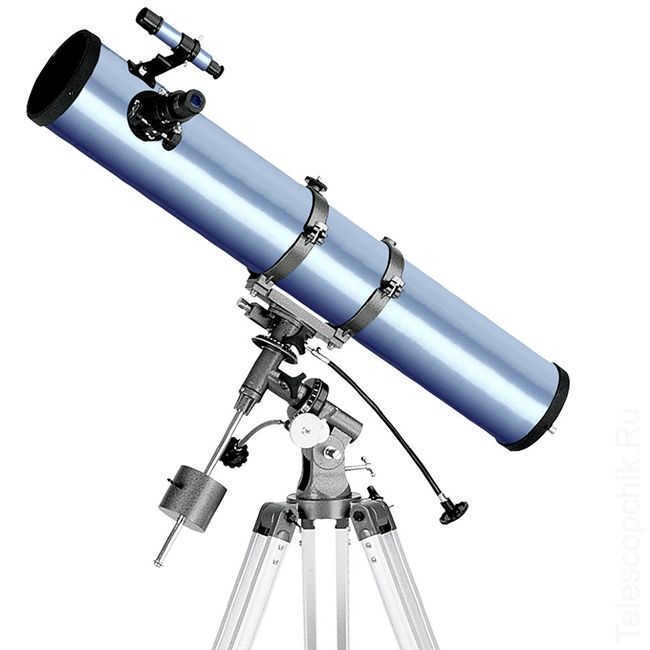
The Reflector telescope utilizes two concave mirrors to capture and transmit light. One mirror is located in the tube lens, while the other reflects the image at an angle, directing it towards the side eyepiece.
In contrast to a refractor telescope, this type of optics is better suited for observing deep space and obtaining high-quality images of distant galaxies. Mirrors are less expensive to produce compared to lenses, resulting in a more affordable price for these instruments. However, beginners or children may find it challenging to handle the complex adjustments and image correctors associated with reflector telescopes.
- Simple design;
- Compact and lightweight;
- Excellent for capturing faint light from distant cosmic objects;
- Large aperture (ranging from 250 to 400 mm) provides a brighter and clearer image without distortions;
- Lower price compared to similar refractor telescopes.
- Adjustment of the device requires both time and experience;
- The open design of the device makes it susceptible to dust and dirt infiltration;
- Temperature fluctuations are a cause for concern;
- This device is not suitable for observing terrestrial and nearby solar system objects.
Mirror-lens catadioptric telescopes
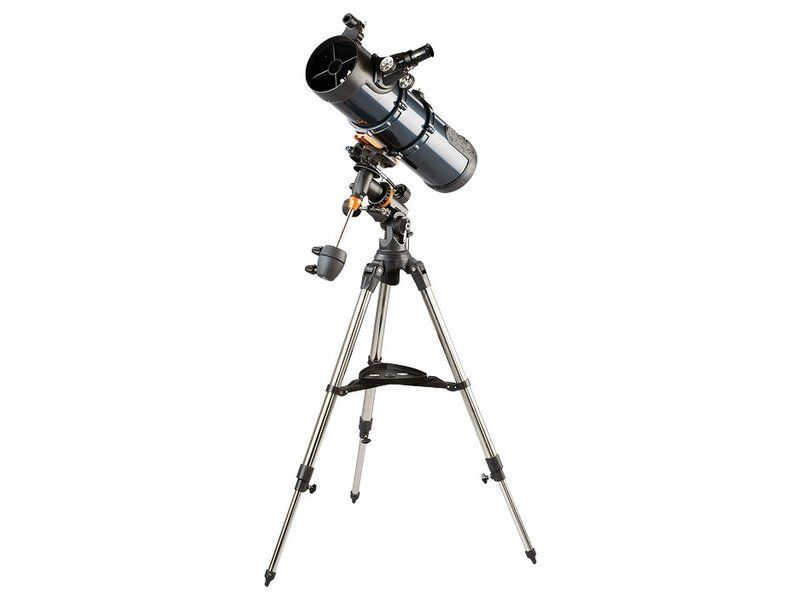
The catadioptric telescopes have a unique design that combines lenses and mirrors, allowing them to provide the best image quality by compensating for defects with special correction plates.
These telescopes are highly versatile, suitable for observing both distant and close astronomical objects, making it possible to capture high-quality images.
- Compact and portable
- Equally effective for observing deep space and nearby objects
- Superior image quality
- Available in aperture sizes up to 400 mm
- Higher cost
- Longer time required for thermal stabilization of air inside the tube
- Complex construction
Factors to Consider When Selecting a Telescope

If you’ve made the decision to purchase a telescope, it’s important to establish your fundamental requirements for this instrument.
The design and performance of the optics will be determined by your answers to several key questions:
1. What celestial objects are you interested in viewing – planets within our solar system or distant galaxies?
2. Where will you be observing cosmic bodies – from your balcony, or will you have the opportunity to take a telescope into the field?
3. Do you have plans to engage in astrophotography?
Now let’s proceed to the primary characteristics of modern telescopes.
Aperture (lens diameter)
The primary factor to consider when selecting a telescope is the aperture of its lens. This parameter determines the lens or mirror’s ability to gather light: the larger the aperture, the more light rays it can capture. Consequently, a larger aperture lens will provide higher image quality and even detect faint reflected radiation from distant celestial objects.
When deciding on the appropriate aperture for your needs, consider the following guidelines:
1. For clear views of nearby planets or satellites, a device with a lens diameter up to 150mm will suffice. In urban environments, it is advisable to reduce this measurement to 70-90mm.
2. A device with an aperture exceeding 200mm will have the capability to observe distant galaxies.
What is Focal Length?
Focal length refers to the distance between the lens and the point in the eyepiece where all the light rays are brought together to form a beam. The level of magnification and the quality of the image that we see depend on this characteristic – the higher the focal length, the clearer the object of interest will appear.
The focal length affects the overall length of the telescope, which in turn affects its portability and storage. Naturally, it is more convenient to store a telescope with a shorter focal length, typically around 500-800 mm, on a balcony. This limitation does not apply to catadioptric telescopes, as the light is refracted multiple times, allowing for a shorter body length.
Magnification Ratio
The magnification ratio can be determined by dividing the focal length of the telescope by the focal length of the eyepiece. For instance, if the telescope has a focal length of 800mm and the eyepiece has a focal length of 16mm, the resulting magnification will be 50x.
To adjust the magnification of objects, you can use different eyepieces with stronger or weaker focal lengths. Nowadays, manufacturers offer a wide range of eyepieces with focal lengths ranging from 4mm to 40mm. Additionally, Barlow lenses are available that can double the telescope’s focal length.
1. It is advisable to focus on close celestial bodies, such as the Moon, for a detailed observation.
2. When observing distant galaxies, high magnification is not as crucial.
Type of telescope mount
A telescope mount is an essential component to ensure the ease of use of the instrument.
When purchasing amateur or semi-professional optics, you will usually find one of three main types of specialized movable supports:
1. Azimuthal mount – This is the simplest type of mount that allows for horizontal and vertical movement of the telescope. It is commonly equipped with refractors and small catadioptrics. However, it is not suitable for astrophotography as it does not provide clear images.
2. Equatorial mount – Although it is heavier and larger in size, the equatorial mount is ideal for locating specific celestial objects based on given coordinates. This type of mount is particularly popular among enthusiasts of reflectors, which are capable of observing distant galaxies that are not visible to the naked eye. It is also favored by astrophotography enthusiasts.
3. The Dobson system is a combination of an affordable and user-friendly azimuthal stand and a dependable equatorial design. It is commonly paired with high-powered and costly reflectors.
How to select a telescope
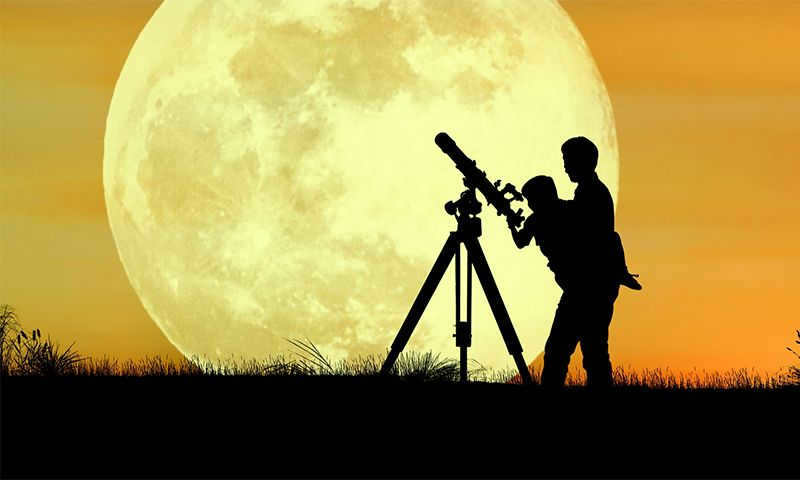

1. For beginner stargazers living in urban areas, it is recommended to purchase a short-focus refractor telescope with an aperture of 70-90 mm on an azimuth mount. If there are opportunities to observe the night sky in more remote locations, one can consider investing in a refractor telescope with an aperture of 110-250 mm and a Dobsonian mount.
2. If your ultimate goal is to explore distant galaxies and nebulae, a reflector telescope with a lens diameter of 250 mm or larger, paired with an azimuth mount, would be the ideal choice.
3. Travelers or those who plan to frequently transport their telescope would benefit from a lightweight and dependable SLR telescope equipped with either a Dobsonian or azimuth mount.
For a young student aged 8-10 who is fascinated by the stars, a great gift would be an affordable and user-friendly refractor telescope from a special children’s series. This telescope features a 70 mm aperture and is mounted on an azimuthal mount for easy maneuvering. To enhance the experience, an additional camera adapter is included, allowing the student to capture stunning images of the moon and other objects on Earth.
What is the price of the telescope?
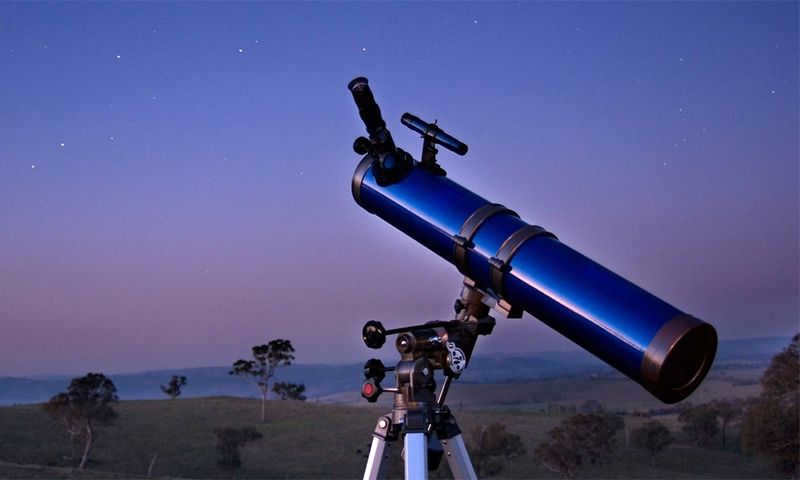
1. You can purchase a refractor on an azimuthal mount for a price ranging from 3500 to 25000 rubles. The price will depend on the technical specifications of the optics and the features of the device.
2. An equatorial mount mirror reflector will cost you anywhere from 14 to 55 thousand rubles.
3. For a professional and high-powered catadioptric device, you will need to spend between 18-95 thousand rubles.
4. The price of a basic children’s telescope starts at 1000 rubles and can go up to a rather “adult” 25 thousand rubles.
5. Telescopes with astrophotography capabilities can range in price from 10 thousand rubles to as high as 3 million rubles.

Yaroslava Klochko
An expert in the field. Offline – a specialist in ensuring product excellence. Over the course of 8 years, I have been creating original content for various online platforms and managing successful commercial blogs. Since 2020, I have taken on the role of editor-in-chief at the VYBOROVED project, which has led to my family and friends seeking my advice before making significant purchases. I strive to uncover any hidden flaws in a given topic and bring them to light. To get in touch, please reach out via email.
There is an abundance of outstanding options when it comes to selecting the best telescope for astrophotography, leaving users spoiled for choice. Whether you are a novice seeking an affordable telescope to delve into this new pastime, or an experienced astrophotographer looking to upgrade your equipment, this article presents seven telescopes that are ideal for your hobby.
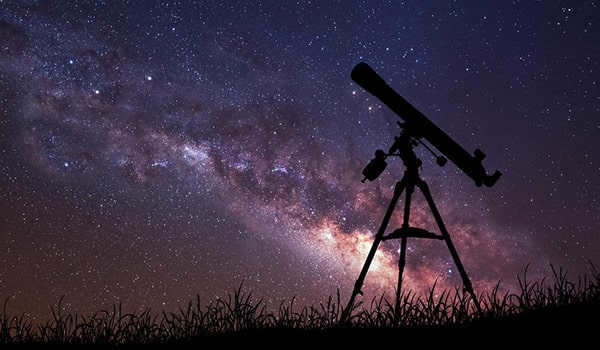
Key factors for astrophotography-friendly telescopes
When it comes to astrophotography, the telescope you choose may vary from the one you use for stargazing. In this article, we will explore the essential features that contribute to a successful astrophotography experience.
Aperture
The size of the lens is referred to as the aperture. The aperture required for astrophotography may differ from what is needed for stargazing. The rationale behind this is quite simple: outer space is predominantly dark. When engaging in astrophotography, it is crucial to capture as much light as feasible in order to obtain a clearer image of celestial objects. To achieve this, a wide aperture is necessary.
Focal length and ratio
Focal length is the distance at which a telescope can achieve focus.
- Greater magnification can be achieved with longer focal lengths, but this also means a smaller field of view and aperture. Longer focal lengths are ideal for observing small, distant objects like the Moon and planets.
- Shorter focal lengths provide lower magnification but larger fields of view. They are suitable for capturing faint and distant objects like galaxies and the Orion constellation.
While focal length plays a significant role in the resulting image, aperture is equally important.
The aperture value is directly tied to the focal length. This value, also known as the focal ratio, is determined by dividing the focal length by the aperture size. Essentially, it indicates the amount of light the telescope captures.
Before making a purchase, it’s important to determine your priorities. Do you prefer panoramic views, like those of the Milky Way? If so, a higher aperture may be necessary. Or perhaps you’re more interested in detailed close-ups of objects like Mars, in which case a smaller aperture will suffice.
Mounting
Many telescopes are sold without mounts, allowing you to choose the one that best fits your needs and priorities.
The mount is a crucial component for astrophotography. You don’t want a shaky mount that will ruin your photos or prevent you from capturing long-exposure images. Take a moment to consider the following:
- What size telescope does the mount need to support?
- Where do you plan to set up the telescope? Will a table mount suffice, or do you need a full-size tripod?
- Are you planning on traveling frequently with your instrument? Is it crucial for your mount to be portable?
It may sound a bit peculiar, but the mount is actually one of the most critical factors to consider in the realm of astrophotography. Why, you may ask?
Well, due to the Earth’s rotation, it is essential to take this into account; otherwise, your images will turn out blurry or with streaks on them. This occurs because your telescope remains stationary and fails to focus on a specific object.
When it comes to choosing a mount, there are two types worth considering: altazimuthal and equatorial. Each type has its own advantages and disadvantages. Altazimuthal mounts have the ability to move up, down, left, and right, making them relatively easy to use and cost-effective.
On the other hand, equatorial mounts move in accordance with the Earth’s rotation. This means that you can more effortlessly and smoothly track the changing positions of celestial bodies throughout the night.
While there are various types of mounts that can be used for astrophotography, the most practical option for handheld telescopes is often an equatorial mount. However, when it comes to computerized telescopes, they can be of any type.
A comprehensive review of the top 7 instruments for astrophotography
If you are interested in venturing into the world of astrophotography, be prepared for a potentially costly endeavor. Not only will you need a high-quality camera specifically designed for astrophotography, but you will also require a compatible telescope. The good news is that these devices are available at a wide range of prices, catering to various budgets.
To assist you in finding the perfect telescope for your astrophotography needs, we have examined some of the essential features that you should consider. Additionally, we have compiled a list of our top 7 telescope recommendations, spanning across different price points.
Our pick is the Sky-Watcher ProED 120mm
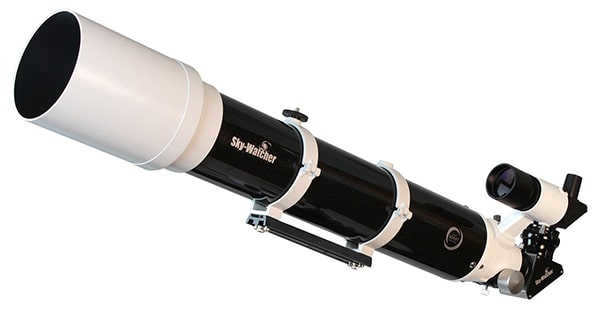
Type: refractor.
Aperture: 120mm.
Weight: 13.6 kg.
Focal length: 900 mm.
Focal ratio: f / 7.5.
Optional equipment: Schott BK-7 and FPL-53 ED glass, 8 × 50 RA direct image finder, 2-inch dielectric diagonal.
If you are a beginner or in search of your next go-to telescope, the Sky-Watcher ProED can be considered the ultimate option for astrophotography enthusiasts.
Featuring a 120mm aperture, this telescope allows you to capture incredibly sharp images of planets and celestial objects you wish to explore. Equipped with ED Schott glass and boasting a focal length of 900mm (f / 7.5), it excels in terms of image sharpness, making it a standout choice.
The size of the viewfinder is 8 × 50 RA with a dielectric diagonal measuring 2 inches, making it the top choice in its category. The Sky-Watcher ProED is equipped with tube ring mounts and even comes with a convenient aluminum carrying case for easy transportation to and from the viewing area.
The Sky-Watcher ProED is compatible with high-performance ED-APO refractors and delivers outstanding optical performance for both amateur and beginner astronomers.
With its renowned exceptional contrast, high resolution, and pitch-black sky background, this type of telescope ensures that the stars and other celestial objects in your images will shine brilliantly.
Celestron StarBright XLT is the preferred option for substitution
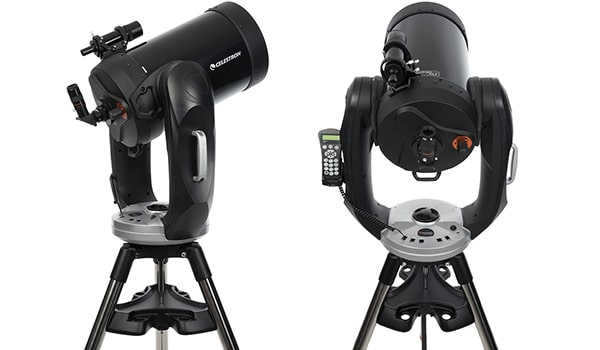
Specifications:
- Type: Schmidt-Cassegrain.
- Aperture: 280 mm.
- Weight: 29.5 kg.
- Focal length: 2800 mm.
- Focal ratio: f / 10.
- Optional equipment: alt-azimuth mount, 661x magnification, database of over 40000 celestial objects, 9 × 50 finder.
The Celestron StarBright XLT offers exceptional optical system performance and high transmittance, allowing for incredibly sharp images. Additionally, it captures a significant amount of incident light at the focal plane.
If you are in search of a telescope that excels in both visual observation and photographic imaging, this is the ideal choice for you.
The Celestron StarBright XLT is equipped with a 280mm aperture and a 2800mm focal length, enabling you to explore the depths of outer space. What sets it apart is its incorporation of three key components that enhance the design of its high throughput optical system.
One standout feature is its specially developed multi-layer mirror coatings, which utilize aluminum, SiO2, TiO2, and SiO2. These coatings not only enable real-time observation but also facilitate the capture of high-quality photographs.
Additionally, the telescope boasts multi-layer brightening coatings made with MgF2 and HfO2, allowing for increased bandwidth and improved performance.
Another notable aspect is the use of high transmittance white water-white glass for the corrector lens, as opposed to lime-sodium glass. This choice not only makes the lens highly anti-reflective but also significantly enhances the overall image quality.
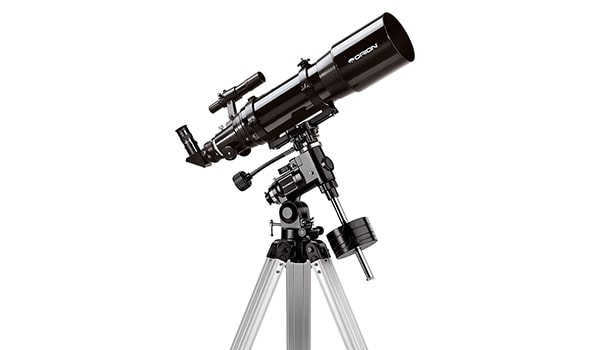
Type: refractor.
Aperture: 120 mm.
Weight: 16.5 kg.
Focal length: 600 mm.
Focal ratio: f / 5.
Optional equipment: 6 × 30 finder, 2 Sirius Plossl eyepieces, 2-inch focuser, height-adjustable aluminum tripod.
The Orion 9005 AstroView is an excellent choice for beginner astronomers interested in astrophotography. With its wide field of view refractor design, it allows you to capture stunning images of deep space objects. The telescope’s 120mm aperture and 600mm focal length ensure crystal clear resolution, enabling you to observe even the most distant celestial bodies.
Whether you’re interested in photographing nebulae, star clusters, galaxies, or capturing detailed images of the Moon and planets, the Orion 9005 AstroView is the perfect tool for the job.
When you buy the Orion 9005 AstroView, you will also receive a versatile tripod and an equatorial mount for precise manual tracking of celestial objects. This feature is especially useful when the object is in motion. Additionally, this unit includes internal polar alignment for accurate operation. But that’s not all – it also comes with two 1.25-inch Sirius Plossl eyepieces, a 6 × 30 finder, a stylish 2-inch stand and gear focuser, a 90-degree mirror star, and Starry Night astronomy software. This comprehensive bundle makes it an excellent choice for beginners.
The Celestron NexStar 5 SE is considered the top choice when it comes to capturing breathtaking images of the deep space with a telescope.
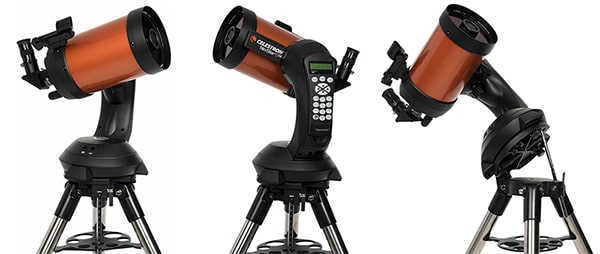
Specifications: Type – Schmidt Cassegrain, Aperture – 125 mm, Weight – 8 kg, Focal length – 1250 mm, Focal ratio – f / 10, Optional equipment – alt-azimuth single fork mount, stainless steel tripod, database of 40000 celestial objects, SkyAlign technology.
Celestron NexStar 5 SE is an exceptional telescope known for its remarkable performance in deep space astrophotography. With its long focal length and advanced features, it stands as one of the top choices for astrophotography enthusiasts.
This Schmidt-Cassegrain telescope has a 125mm aperture and f / 10 focal ratio, making it incredibly powerful and versatile. It not only offers exceptional performance but also ensures user-friendly operation. It comes with a comprehensive set of components, providing users with everything they need to observe high-quality celestial objects.

